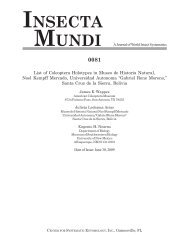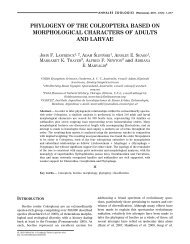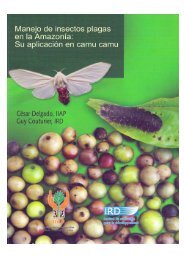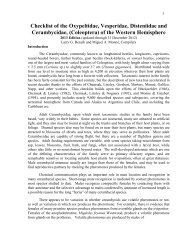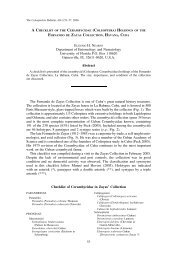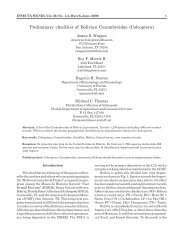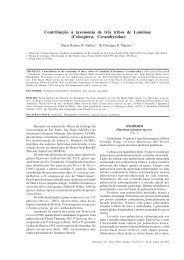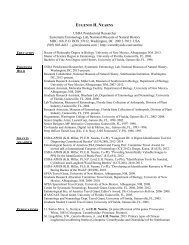- Page 2 and 3: ^'^mW'^THQZnAS ILWC0LHCASETLIBRARY1
- Page 5 and 6: :::THE FAUNA OF BRITISH INDIA,INCLU
- Page 7 and 8: PREFACE.This short volume is the fi
- Page 9 and 10: LIST OV THE PRINCIPAL WORKS QUOTED
- Page 11 and 12: WORKS QUOTED.VULinn. Syst. Nat. Sys
- Page 13 and 14: —;EXPLANATION OF THE TEKMS USED F
- Page 15: XISUPERFAMILYLONGICORNIA.The superf
- Page 18 and 19: ...XIVSYSTEMATIC INDEX.3. plagiata,
- Page 20 and 21: ....SYSTEMATIC INDEX.3. angustuluni
- Page 22 and 23: ..SYSTEMATIC INDEX.4. phiale, Gahan
- Page 24 and 25: 2. CEKAMBYCIDyE.Syno'psis of Subfam
- Page 26 and 27: 4 CEEAMBIClD.i;.
- Page 28 and 29: 6 CEEAMBTCID.E,depressed, separated
- Page 30 and 31: CEBAMBTCIDJE.Elytra almost twice as
- Page 32 and 33: .10 CEEAMBTCID^.p. 210 (1844).d . D
- Page 34 and 35: —12 CERAMBYCID^.Last joint of pal
- Page 36 and 37: ;14 CERAMBTCID.I.feebly dentate at
- Page 38 and 39: 16 CERAMBYCID.i:.long, bispinose at
- Page 40 and 41: —18 CEEAMBTCID^.aud narrower ; th
- Page 42 and 43: —;20 CEBAMBYCIDjE,with a basal ba
- Page 44 and 45: 22, CEEAMBICIDJE.2 . Aiitennce uiti
- Page 46 and 47: .24 CERAMBYCID-i:.nitid and sparsel
- Page 50 and 51: —28 CEEAMBTCIDy^:.This group, whi
- Page 52 and 53: 30 CEEAMBYClD.f:,B. Third auteunal
- Page 54 and 55: 32 CERAMBYCID.E.tlie fore legs aspe
- Page 56 and 57: ;34 CERAMBYCID.?'.the antennae with
- Page 58 and 59: 36 CERAMBYCID.^.in front, densely a
- Page 60 and 61: 38 CEBAMBYCLD^.shining spaces on th
- Page 62 and 63: 40 CEEAMBYCID.I.in the male ;the di
- Page 64 and 65: ;42 CERAMBTCID.i;.Genus BARALIPTON.
- Page 66 and 67: ;;44 CERAMBYCID.i:.the sides, the l
- Page 68 and 69: 46 CEEAMBYCli)^.three times as long
- Page 70 and 71: ;48 CERAMBYCIDiE.third joint closel
- Page 72 and 73: ;50 CEliAMBYCID.i:.Genus DANDAMIS,
- Page 74 and 75: ;52 ceeambycidjE.punctm-ed ;third t
- Page 76 and 77: ;54 CEEAMBTCID^.the others graduall
- Page 78 and 79: 56 CEEvAMBYCID^.cavity. Elytra bi'o
- Page 80 and 81: 58 CEEAMBTCID^.Subfamily II.DISTENI
- Page 82 and 83: .60 CEEAMBTCID^.the epimera. Metath
- Page 84 and 85: ;62 CEEAMBTCIDiE.elytra ; first joi
- Page 86 and 87: 64 cerambycib;e.hind femora I'eachi
- Page 88 and 89: ;60 CBllAMBYCID.^.regularh" punctur
- Page 90 and 91: 68 cekambycidjE.Subfamily III.LEPTU
- Page 92 and 93: ;70 CEEAMByCID^.base, gradually nar
- Page 94 and 95: 72 CERAMBYCID.E.succeeding joints n
- Page 96 and 97: 74 CEEAMBTCID^.This species is clos
- Page 98 and 99:
76 CERAMBYCID.1:.A-^ertex faintly i
- Page 100 and 101:
78 CERAMBYCID.E.the front by a sinu
- Page 102 and 103:
shouldersoCERAMBYCID.E.strongly nar
- Page 104 and 105:
—82 CEllAMBYCIU-i;.aud dull, but
- Page 106 and 107:
84 CEKAMBYCID.E.78. Leptura clytina
- Page 108 and 109:
86 CERAMBYCID,?:.segment pavallel-s
- Page 110 and 111:
eCEEAMBYCID.I-.feebly sinuate at th
- Page 112 and 113:
;90 CERAMByCIU.E.side of the middle
- Page 114 and 115:
92 CERAMBTCID.i:.6'.Front coxae rou
- Page 116 and 117:
—94 CERAMBYCID.i:.with small gran
- Page 118 and 119:
;96 CERAMBTCIBA.the base, the rest
- Page 120 and 121:
98 CERAMBYCIDJE.punctate, the narro
- Page 122 and 123:
—;100 CEEAMBTCID.i:.with the firs
- Page 124 and 125:
;102 CEEAMBTCIDiB.and along each si
- Page 126 and 127:
;104 CERAMBTCID.E.Genus HYPOESCHRUS
- Page 128 and 129:
106 CERAMBYCID^.the lower lobes ext
- Page 130 and 131:
108 CEKAMBYCID.!:,squarely turned i
- Page 132 and 133:
110 OERAMBYClD.i:.Si/nojysis of the
- Page 134 and 135:
112 CERAMBTCID.T.two contiguous ivo
- Page 136 and 137:
—.114 CERAilBTCID.E.Genus STEOMAT
- Page 138 and 139:
;116 CEUAMBTCID,?:.gradually and su
- Page 140 and 141:
118 CERAMBTCID.i:.discal tubercles
- Page 142 and 143:
;120 CERAMBYCID.i:.b'.b^. Auteniial
- Page 144 and 145:
;122 CERAMB\CID-I.but rather dense
- Page 146 and 147:
124 CER.A MBYCID.5;.120. Plocaederu
- Page 148 and 149:
126 CEBAMBYCID.i:.very strongly, th
- Page 150 and 151:
;128 CEEAMBTCID^.exhibit bands or p
- Page 152 and 153:
;130 ceeambtcib.t:.129. Massicus un
- Page 154 and 155:
—:132 CEBxVilBYCID^.antennjB of t
- Page 156 and 157:
—134 CEEAMBYCID.E.vertical; the c
- Page 158 and 159:
;136 CEEAMBTCIDJ!.the base, where a
- Page 160 and 161:
138 CERAMBTCID.T-.,138. Margites mo
- Page 162 and 163:
;140 CEEAMBTCIDJE.surface except in
- Page 164 and 165:
.142 CERAMBYClDi:.first joint rathe
- Page 166 and 167:
—. ;the liind border of the secon
- Page 168 and 169:
146 cerambycim:.and angulated anter
- Page 170 and 171:
148 CERAMBYCID.^.151. Rhytidodera s
- Page 172 and 173:
150 CERAMBTCID.i;.II.Elytra u'ithou
- Page 174 and 175:
152 CEriAMBYCIB.i:.I. Ebjtra spined
- Page 176 and 177:
;154 CKRAMBYCID.E.truncate with the
- Page 178 and 179:
156 CERAMBYCID.I.as long as their w
- Page 180 and 181:
15SCERAMBTCID.I.punctured at base,
- Page 182 and 183:
;160 CEllAMBYCID.E.169. Ceresium ro
- Page 184 and 185:
162 CEUAMBTCID.r.distinctly longei*
- Page 186 and 187:
;164 CEEAMBYCID.i:.Very closely all
- Page 188 and 189:
166 CER.OIBTCID.i:.densely punctate
- Page 190 and 191:
168 CERAMBYCID.T.Genus IBIDIONIDUM.
- Page 192 and 193:
170 CERAMBYCID.li;.abruptly clavate
- Page 194 and 195:
;172 CEEAMBYCID.T.oval, dorsal tube
- Page 196 and 197:
17-i CEltA.MBTCID.1.on the outer (d
- Page 198 and 199:
;176 CERAilBYCID^,Genus ROSALIA.Eos
- Page 200 and 201:
i/0 CERAMBYCID.i:.fifth 8ubasperate
- Page 202 and 203:
;180 CEEAMBTCID^.the middle and a l
- Page 204 and 205:
;;182 CERAMBYCIDiB.Group MYTHODINl.
- Page 206 and 207:
184 CEKAMBYCID.E.Si/7ioj}sis of the
- Page 208 and 209:
186 CERAMBYCID.!:.white colour; the
- Page 210 and 211:
.188 CERAMBYCID.i:.2U4. EuryphagUS
- Page 212 and 213:
190 cebambycid.t:.a'. Autemue very
- Page 214 and 215:
192 CERAMBYCID.I.2(>7. Zouopterus v
- Page 216 and 217:
194 CEK.vMByciu.i;.narrowed from th
- Page 218 and 219:
;196 CERAMBYCID.'E.punctate, impres
- Page 220 and 221:
;198 CEEAilBYCIB-l:.punctate ; the
- Page 222 and 223:
200 cerambtcidtE.pubescence, on eac
- Page 224 and 225:
;;202 CEEAMBTCID.E.in front, densel
- Page 226 and 227:
;20 i CEEAMBTCID.'B.in front. Anten
- Page 228 and 229:
—205 CKliAMUYClD.E.punctate above
- Page 230 and 231:
:308 CERAMBYCID.i:.228. Aphrodisium
- Page 232 and 233:
210 CEKAMBYCID.B,a bisinuate poster
- Page 234 and 235:
212 CEBAMBYCID^.sixth less deeply e
- Page 236 and 237:
214 CEEAMBYCID.ir.longer than the t
- Page 238 and 239:
216 CEBAMBYCID.i:.rugulose appearan
- Page 240 and 241:
;218 CEBAMBYCIDvE.B. Protliorax ohs
- Page 242 and 243:
220 CERAMBYCID.i:.245. Polyzonus de
- Page 244 and 245:
522 CEEAMBYCID-i:.denselv rufjuiose
- Page 246 and 247:
;224 CEKAMBTCID.'E.Avidenetl again
- Page 248 and 249:
226 CEEAMBYCID.i:.fifth at the base
- Page 250 and 251:
;228 CEKAMBYCID.li.256. Pyrestes py
- Page 252 and 253:
230 CEEAMBYCIDiE,sharply pointed at
- Page 254 and 255:
232 CEKAMBTCID.!.apex on the anteri
- Page 256 and 257:
;234 CERAMBTCID.E,punctured, the si
- Page 258 and 259:
236 CERAMBTCID.i:.Group THRANIINI.H
- Page 260 and 261:
238 CEEAMBTCID.i:.thence of nearly
- Page 262 and 263:
240 ceba-MbtcidjE.Sifnop^iis of Gen
- Page 264 and 265:
242 CEBAMBYCID.D.converge downwards
- Page 266 and 267:
244 CEEAMBTCID^.this species agrees
- Page 268 and 269:
246 CERAMBTCID,!:.Hind femora exten
- Page 270 and 271:
;.248 CERAMBYCID.i:.extend by neai'
- Page 272 and 273:
;250 CEEAMBYCID,^.front wideued bel
- Page 274 and 275:
252 CEEAMBYCID-i:.Yellowish pubesce
- Page 276 and 277:
254- CEBAMBYCID.E.Genus PERIS SUS.P
- Page 278 and 279:
;256 CEEAMBYCID^.Lenr/th 9-12 : bre
- Page 280 and 281:
;258 CEEAMBTCID.E.the (S , slightly
- Page 282 and 283:
260 CEEAMBYCIDyi:,margin ; the apex
- Page 284 and 285:
;262 CEBAMBYCIDJ!.pubescence ; thir
- Page 286 and 287:
;264 CHEAMBYCID^.length from the ba
- Page 288 and 289:
;266 CEEAMBYCID.^.one at the middle
- Page 290 and 291:
a26SCEKAIMBYCIB.E.very feebly denta
- Page 292 and 293:
;270 CEEAMBYCID^.Length 11 ;hrcadth
- Page 294 and 295:
272 CEEAMBTCID^.antennae and legs b
- Page 296 and 297:
274 CEEAMBTCID^.;,shorter, the post
- Page 298 and 299:
;276 CEEAMBTCTDJ5.326. Rhaphlima fa
- Page 300 and 301:
278 CERAMBTCIDJ.of the elytra in th
- Page 302 and 303:
280 CEBAMBYCID.E.334. Clytocera chi
- Page 304 and 305:
282 CEEAMBTCID.E.feebly spined post
- Page 306 and 307:
2S4CERAMBYCID^.pubescence that cove
- Page 308 and 309:
286 CERAMBYCID.i:.length in the c?
- Page 310 and 311:
—288 CEEAMBTCID^.346. Demonax dec
- Page 312 and 313:
290 CEB.VMBTClDiE.margin to vvithin
- Page 314 and 315:
292 CEEAMBYCID.i:.fourth joint stro
- Page 316 and 317:
204 CERAMBYCID.E.and fourth joints
- Page 318 and 319:
296 CEEAJJBXCID.i:.spots and two ve
- Page 320 and 321:
298 CERAMBYC1D.5:.first abdominal s
- Page 322 and 323:
.300 CEKAMBTCIDyi;.This genus resem
- Page 324 and 325:
302 CERAMBYCID.'E.what prominent, n
- Page 326 and 327:
304 CERA.MByciD.i:.first two bands
- Page 328 and 329:
—,306 CER.VMBTCID.E.the apex ; ea
- Page 330 and 331:
.;308 CEEAMBYCID.I.raised, transver
- Page 332 and 333:
310 CEltAMBTCID.i:.apical margin ;
- Page 334 and 335:
;312 CERAMBYCID.i:.384. Halme cseru
- Page 336 and 337:
314 cerambyciDjE.Sijno2)sis of Gene
- Page 338 and 339:
316 CERAMBXCID.i:.387. Dere affiiii
- Page 340 and 341:
318 CEUAMBTCID^,Genus NIDA.Nida, Pa
- Page 342 and 343:
320 CEEAMBl'CID.E.below the base of
- Page 344 and 345:
322 CEHAMBYC'ID.i:.in length to the
- Page 346 and 347:
..324 ALPHABETICAL 1XJ)E.\;.callidi
- Page 348 and 349:
326 ALrilAULTlf.VL IXDKX,Thidiouidu
- Page 350 and 351:
328 ALPII AB F/ri( 'A I. 1 X DEX.py
- Page 354 and 355:
. -r.^'-5^ -4S>i^^::Sft,V-'.,l,if:j


![Coleoptera. Vol. I. [Longicornia. Part I.]](https://img.yumpu.com/41202793/48/500x640/coleoptera-vol-i-longicornia-part-i.jpg)
